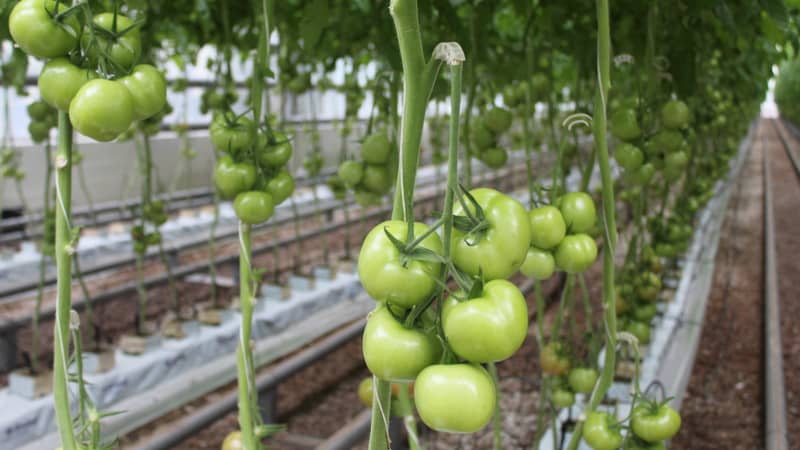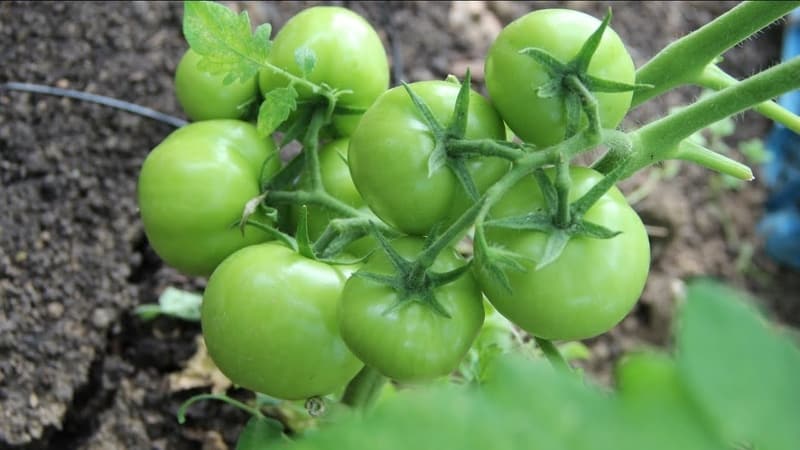Solving problems with the tomato harvest: what to do if the tomatoes in the greenhouse don’t turn red
Every vegetable grower wants to get a rich harvest, but the efforts made do not always pay off. Growing tomatoes in a greenhouse does not guarantee that the fruits will be juicy and large. In this article you will learn why tomatoes in a greenhouse do not turn red, what to do to make them grow larger, and how to speed up their ripening.
Causes of problems and how to solve them
Nightshades ripen in two stages. The first phase takes 3-4 weeks and occurs after the formation of the ovary. At this time, the fruit gains volume, becomes firm and green. The second stage lasts from 12 to 20 days - the tomatoes gradually fill with juice and change their color from light to scarlet.
If the fruits develop correctly, no additional measures will be needed. The situation is considered a deviation if, 7 weeks after the formation of the ovary, the tomatoes still remain small and green. It is important to correctly determine the cause of the problem.
Reasons for delayed ripening of tomatoes:
- Uncomfortable temperature. The fruits contain lycopene, a natural pigment that gives them their red color. The production of this substance is inhibited if the temperature in the greenhouse drops below +15°C or exceeds +35°C.
- Insufficient lighting level. Tomatoes may stop turning red due to excessive thickening of the bushes. In areas with dense vegetation, fruits on the upper branches turn red most quickly, while tomatoes below can remain green for a long time.
- Using the wrong fertilizer. An excess of nitrogenous fertilizers leads to the formation of small, deformed fruits that do not turn red for a long time.
- Incorrect formation of the bush and overload of fruits. Due to the large number of ovaries, the stem, leaves and fruits do not receive proper nutrition.
Methods to accelerate maturation
To obtain a rich harvest, you need to ensure that comfortable conditions are established in the greenhouse or greenhouse. Eliminating discomfort will speed up the growth of small fruits.
You can speed up the ripening rate of tomatoes using the following methods:
- Selection of the right fertilizer.
- Creating favorable conditions: the correct temperature, humidity level and light.
- Mandatory formation of the bush: pinching, pruning leaves and flowers.
Why tomatoes don’t pour, but turn small red
Small fruits may be a symptom of improper feeding. An excess of nitrogen leads to the growth of green mass, while a lack of phosphorus and potassium prevents the fruits from gaining volume.
Why does a tomato turn red with green spots near the stalk?
Such symptoms may indicate a temperature disorder. A delay in fruit development occurs if temperatures fall below +15°C or exceed +35°C.
A yellow-green edging near the stalk can also be a consequence of sudden temperature changes between day and night.
How to speed up the ripening process of tomatoes
The key to large and juicy fruits is feeding. Many summer residents strive to make their harvest as environmentally friendly as possible, so they do not use chemicals. How can you feed the plants in this case?
Effective fertilizers for tomatoes:
- Iodo-ash fertilizer. Pour 2 liters of crushed ash into a bucket and pour 5 liters of boiling water. When the mixture has cooled, add another 5 liters of settled water to the container. The bucket is covered and placed in the shade. After a week, the infusion of ash is poured into another container, into which 20 ml of 5% iodine and 10 g of boric acid are then added. The resulting concentrate must be diluted with settled water in a ratio of 1:9. One bush will need 0.8-1 liters of solution.
- Superphosphate extract. Pour 100 g of granulated phosphate into an enamel bowl and pour 5 cups of boiling water over it. Set aside the mixture for one day, stirring it occasionally to completely dissolve the granules. After a day, drain the hood, 20 tbsp. l. dilute the product with 3 liters of water. The resulting concentrate is diluted in a ratio of 3/4 cup to 1 bucket of water. One bush will need 1 liter of solution.
How to make tomatoes turn red
Once the cause of the developmental delay is determined, you can begin to eliminate it.
Forming a bush correctly
An important condition for the development of nightshades is the formation of a bush. Otherwise, all the nutrition is spent on the development and maintenance of green mass, which is why the fruits remain small and green.
For proper bush formation indeterminate varieties, it is necessary to remove the lateral shoots of the plant once a week. If the bush is very powerful, then a lateral stepson is left on the main stem, which is later pinched to form a flower cluster. Also, in the first half of August, it is necessary to trim the tops of plants 3 leaves above the fruit cluster. In this case, be sure to cut off the flowers and small ovaries.
Semi-determinate varieties and hybrids grow in two stems, so a stepson is left on the main stem under the initial flowering cluster.The shoots that appear later are removed. If by mid-August the bush has not been formed correctly, its tops are cut off.
Determinate tomatoes do not need pinching. The bush of such varieties has three trunks; side shoots must be removed.
Superdeterminate and standard tomatoes do not require shaping or pinching.
Important! Excessive plant weight can take away nutrients; leaves in contact with the soil can become a source of many diseases. Therefore, as a preventative measure and to quickly ripen tomatoes, many people cut off the lower leaves of plants.
Maintaining humidity in the greenhouse
Humidity levels play an important role in proper fruit formation. To quickly ripen tomatoes, you can arrange something like a Finnish sauna in the greenhouse.
- Stop watering the plants.
- Every morning, ventilate the room for 1.5-2 hours.
- You should close the greenhouse only when all the condensation that has accumulated overnight has completely dried.
- Keep greenhouse windows and doors closed throughout the day.
- During hot periods in the evening, you can open the windows for 1 hour.
Peculiarity. This method, in addition to rapid ripening, will protect the crop from late blight. Dry hot air prevents the growth of fungus, the causative agent of the disease.

We use supports, trellises and a garter
Often the upper fruits ripen quickly, while the lower ones remain green for a long time. This problem can be eliminated through thinning, as well as the use of supports and trellises.
Additional funds will also be needed if the bush is overloaded with fruits. Today, supports for tomatoes can be purchased at the store or made with your own hands. They help plants get more sun and ripen faster.
The garter helps the plant not to break under the load of ripe tomatoes. For these purposes, you can use soft but durable fabric, for example, nylon.
Provide plants with enough light
Early varieties usually have enough sunlight to ripen. However, as summer ends and autumn approaches, daylight hours decrease, so tomatoes may experience a lack of light, which prevents them from turning red.
The situation can be corrected if you turn the fruiting branches towards the sun and fix them in this position. It is best to lift clusters of fruits from under the green mass. To avoid damaging the branches, you will need supports.
We use fertilizers correctly
Incorrect selection of fertilizers is the most common cause of stunted tomato growth. Deficiency or excess of useful elements affects the growth and ripening of fruits.
How to determine an excess of nitrogen fertilizers? With this problem, nightshades have dense, thick green shoots and small fruits.
Important! During the period of fruit set, formation and ripening, nitrates should not be used. For feeding It is better to use phosphorus, iodine and potassium.
The problem of excess fertilizer can be solved by abandoning nitrogen-containing fertilizers and switching to ash infusion and superphosphate extract.
We maintain the temperature regime in the greenhouse
During the period of pollination and formation of ovaries, the values in the greenhouse should not exceed +27°C. Once all the fruits have reached their maximum volume, they are no longer afraid of the heat. On the contrary, reddening of the fruit occurs at double the rate in hot weather.
Removing new flowers
In autumn, flowers continue to form on the plants, but at this time they interfere with the ripening of the fruits.Therefore, you need to remove them as they grow - you can pinch or trim all the growth points of the plant.
Recommendations from gardeners

Carrying out stepsoning and leaf pruning are mandatory procedures for most tomato varieties. However, novice gardeners can harm the plant through their actions and even lead to its death.
Correct removal of stepchildren:
- side shoots are broken off by hand without using scissors;
- the procedure is carried out in the early morning of a sunny day;
- The first removal of shoots is done 2 weeks after transplanting the seedlings;
- the frequency of the procedure is 8-12 days;
- All shoots 4-7 cm long must be removed;
- do not break out the shoot by the roots, it is better to leave 2 cm of the shoot;
- the procedure cannot be carried out immediately after feeding or glaze;
- To disinfect the damaged area, you can use a solution of potassium permanganate.
Proper pruning of leaves:
- pruning of leaves begins in the second decade of June;
- the procedure is carried out weekly along with stepsoning;
- you need to cut 1-2 leaves at a time until all the green mass below the first flower cluster is removed;
- You cannot remove 2 leaves before the ovary, as they feed the fruit.
If favorable conditions are established in the greenhouse, but the tomatoes are still not ripe, you can use traditional methods.
- Insert a toothpick near the stem into each green fruit. 2-3 punctures, 2.5 cm deep, are enough.
- Pick the ripest tomato and put it in a plastic bag. A bag is placed on the bunch of green tomatoes; you can secure it with a soft cloth. 3 days are enough for all the fruits to ripen.
- Inject 0.5 ml of vodka into each tomato using a fine-needle syringe.
Conclusion
Gardeners face many problems when growing tomatoes in a greenhouse. Usually the fruits turn red throughout the entire garden, but there are times when some of them stubbornly refuse to ripen. It is important to correctly identify the cause of developmental delay and eliminate it.
There is no need to immediately pick green fruits. With a little effort, you will reap a rich harvest of large, juicy tomatoes.
There seems to be something wrong with the superphosphate extract. There is very little fertilizer for 10 liters of water.